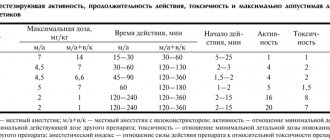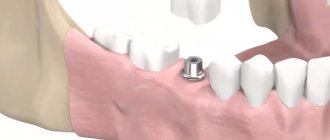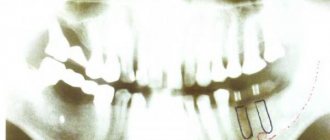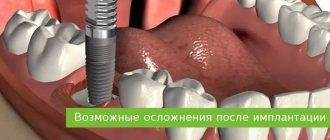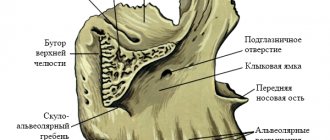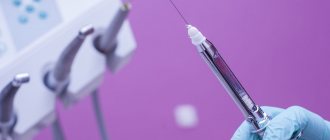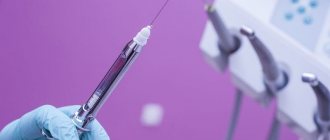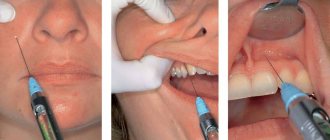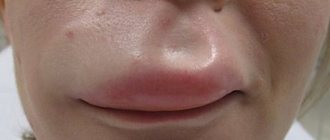The level of effectiveness of a patient's dental treatment in dentistry largely depends on whether the treatment is painless. After all, the problem of pain in patients is important and quite relevant. People, by postponing a visit to their dentist, trigger the disease because they are afraid of the pain of dental treatment.
However, there are different methods of dental anesthesia, which can completely eliminate all pain through high-quality anesthesia. Effective local anesthetics in dentistry are an excellent solution to completely eliminate pain when treating the oral cavity or teeth, because they allow you to maintain a connection between the patient and the doctor. The anesthetic dulls the receptors, which leads to blocking pain during dental or oral treatment.
Types of anesthesia used in dental practice
When treating the oral cavity and teeth, anesthesia is used - general or local.
Anesthesia (general anesthesia) is used quite rarely. With this anesthesia, the patient is unconscious while the treatment is underway and does not feel anything. Anesthesia (general anesthesia) is used only for major operations or when treating children. This type has too many contraindications and all sorts of complications, so dentists almost always prefer local anesthesia. This is the best option for dental intervention.
Local anesthesia - pain relief by freezing or injection into the gum. In this form, the anesthetic temporarily disables the sensitivity of pain in the area specified for treatment. Tactile sensations are preserved during local anesthesia. The patient feels touch or pressure on the tooth or gum, but the patient has no pain. To numb the patient's upper tooth, a local anesthetic is injected into the gum near the painful tooth. This is infiltration anesthesia. Lower teeth - by injecting the patient with a local anesthetic near the mandibular nerve. This will be a conduction anesthesia. It will lead to numbness of the tongue and lower jaw. In dental practice, there is also topical anesthesia, which will make treatment of a certain area of the oral mucosa painless by applying a special gel or spray to it. This anesthesia will be appropriate before infiltration anesthesia, so that the needle prick is imperceptible to the patient.
When is it better not to remove a wisdom tooth?
It seems that removing the lower wisdom tooth is the best solution to all problems, but this is not always true. In many patients, the eruption of “eights” occurs without complications, and in the future these teeth do not cause inconvenience, so there is no need for surgery. Also, you should not pull out your lower wisdom tooth if:
- dental prosthetics are planned and the third molar can become a support for a bridge;
- "seven" is missing. In this case, the wisdom tooth will take its place;
- caries affects only the upper part of the wisdom tooth. Then, instead of a traumatic removal operation, you can perform a regular filling, the price of which will be lower.
Relative contraindications to wisdom tooth removal are:
- infectious and inflammatory processes affecting the oral cavity
- for example, periodontal disease. In this case, you first need to stop the inflammation and take a course of antibiotics, and only then proceed to remove the molar; - respiratory diseases
- influenza, ARVI. They can provoke postoperative complications; - pregnancy and breastfeeding;
- cardiovascular diseases
in the acute stage.
Components of anesthetics
The anesthetic contains local anesthetics, preservatives, vasoconstrictors and stabilizers. The drug used for local anesthesia for pain relief may not contain all of the listed components. To effectively block impulses from nerve endings, one anesthetic is used, and to prolong the period of action and enhance the analgesic effect, vasoconstrictors (adrenaline) are needed. It is used to create and maintain a sufficient concentration of the drug in the treatment area. Preservatives and stabilizers are used in practice to increase the shelf life of anesthesia.
Easy removal
If the wisdom tooth has erupted correctly, grows evenly and has straight, untwisted roots, then there is every chance of getting by with a simple operation, which is carried out in 4 stages.
- Diagnostics
, including examination and x-ray, allows the doctor to get a more accurate idea of the upcoming operation. - Anesthesia.
Generally, local anesthesia is used for simple wisdom teeth removal. - Tooth extraction.
The doctor applies forceps, gently rocks the tooth and removes it using a special tool - an elevator. If fragments of roots remain in the hole, they are also carefully removed. - Treatment of the hole and suturing of the gums.
Antiseptic and anti-inflammatory solutions are used. In some cases, stitches are placed to protect the wound from bacteria, and the patient is sent back for rehabilitation. As reviews show, in the case of simple removal it takes very little time.
Basic requirements for modern anesthetics
An anesthetic is a unique substance that suppresses the excitability of the receptor, turns off the impulse to the patient’s nerve fibers, after which pain relief occurs.
The anesthetic has basic requirements:
- do not cause dilation of the patient’s blood vessels;
- do not provoke tissue irritation;
- high resistance to sterilization of the drug;
- slow absorption into the blood;
- greater strength and duration of analgesic effect;
- have low toxicity to the patient;
- good analgesic effect during dental treatment.
The local anesthetic has a direct inhibitory effect on the receptor and the permeability of the sodium channels in the patient begins to decrease, while the entry of sodium into the human cell is completely disrupted, after which an action potential is generated and this all leads to a lack of sensitivity and analgesia during treatment. Sensitivity is switched off one by one: at the beginning pain, then taste, then temperature and finally tactile. This is how the process of pain relief occurs.
To prolong the effect of painless treatment, a vasoconstrictor (for example, adrenaline) must be added to the local anesthetic. However, in patients with heart disease, it poses a greater risk of heart attack. A vasoconstrictor can cause the patient to relax the muscles of the bronchi and intestines, dilate the pupils, significantly increase blood sugar, increase tissue metabolism and cause many adverse reactions. But if you exclude adrenaline from the local anesthetic drug, this will lead to ineffectiveness and the patient will not experience pain relief.
The decision to use this substance in treatment should be made by an experienced dentist, as a last resort. After all, after adding adrenaline to the local anesthetic, the effectiveness of anesthesia itself during dental treatment increases significantly and its toxicity for the patient decreases. This occurs due to the very slow absorption of the painkiller into the blood. And sometimes toxic complications that appear during local anesthesia are mistakenly attributed to a side effect of the substance adrenaline.
Classification of anesthetics in dentistry
Before dental treatment, the doctor should choose an effective local anesthetic agent individually for each person. The appropriate anesthetic is selected depending on the procedure itself, the duration of the procedure, and the patient's tolerance to the anesthetic drug.
Chemical properties divide the local anesthetic into groups such as substituted amides (articaine, lidocaine, trimecaine) and esters (novocaine, anesthesin, dicaine). These two groups have differences in biotransformation, and most importantly, in side effects for the patient.
Classification according to the method of administration divides local anesthetics in dentistry into those that are used for surface anesthesia and those that are used for conduction and infiltration anesthesia. Based on the duration of its action, anesthetics are classified into short, medium and long-acting.
GBUZ LO "Tosnenskaya Clinical Interdistrict Hospital"
Pain during dental procedures is perceived by patients as a lack of professionalism or a dismissive, inattentive attitude of the doctor. Therefore, anesthesia in dentistry is considered one of the most important stages of treatment, which largely determines its overall effectiveness, as well as its attractiveness to the patient.
Anesthesia in dentistry can be carried out using one of three methods:
- local anesthesia: application, infiltration and conduction;
- general anesthesia - temporary reversible loss of consciousness and all types of sensitivity;
- Potentiated analgesia (sedation) is a combination of local anesthesia with systemic administration of a narcotic analgesic or anxiolytic.
Local anesthesia
Local anesthesia means turning off pain sensitivity in a limited area by blocking the pain impulse through nerve endings. The drugs act exclusively in the injection area, the patient remains conscious and fully controls his actions. Most dental procedures can be performed under local anesthesia.
Depending on the method of introducing the drug into the tissue, methods of local anesthesia are divided into three types:
- application - the anesthetic is applied to the surface of the skin or mucous membrane and penetrates deeper due to diffusion;
- infiltration – the anesthetic drug permeates the tissue layer by layer;
- Conductive: central and peripheral - a depot of an anesthetic solution is created in the area of passage of a large nerve trunk.
Application anesthesia
The procedure is extremely simple: the anesthetic is applied directly to the skin or mucous membrane without violating its integrity. Preparations for local topical anesthesia in dentistry are produced in the form of gel ointments or concentrated solutions. In the first case, the surface to be numbed is lubricated; in the second, a cotton swab moistened with the drug is placed on it, or sprayed from a spray bottle.
The concentrated anesthetic, due to diffusion, penetrates 2-3 mm deep from the surface of the skin, blocking pain receptors of nerve endings. Pain relief occurs in approximately 3-5 minutes and lasts up to half an hour. The anesthetic substance is practically not absorbed into the blood, so this anesthesia technique is considered the safest.
Advantages of application dental anesthesia:
- painless during implementation;
- the effect occurs quickly;
- no resorptive effect is observed;
- minimal severity of side effects.
Flaws:
- shallow depth of anesthesia;
- short duration of action;
- impossibility of anesthesia of deeper tissues.
In what cases is topical anesthesia used?
- anesthesia of the injection site before injection anesthesia;
- removal of small neoplasms on a thin stalk located within the skin or mucous membrane;
- removal of dental plaque, periodontal applications;
- removal of baby teeth if the roots have already resolved and the crown is held on the mucous membrane;
- additional anesthesia of the pulp before its removal.
Infiltration anesthesia
This type of pain relief refers to injection techniques. The solution is injected deep into the soft tissues, saturating them. In this case, the nerve endings in the area of drug administration are switched off and all tissues soaked in the anesthetic are anesthetized.
Advantages of infiltration anesthesia:
- good control of the anesthesia zone;
- rapid onset of anesthesia;
- satisfactory duration and depth of action.
Flaws:
- a large amount of anesthetic may be required if the anesthesia area is large;
- deformation of soft tissues due to the injection of anesthetic and swelling in the injection area.
Infiltration techniques in dentistry include the following types of pain relief:
- intramucosal and submucosal – provides anesthesia of the mucous membrane and periosteum. In the upper jaw, where the bone tissue is more porous, with the use of modern anesthetics with high penetrating power, the pain sensitivity of several teeth or jawbone can be switched off;
- subperiosteal and plexual - usually carried out after the submucosa, since the injection itself is painful and disables the pain sensitivity of bone tissue and the dental nerve (the solution penetrates deep into the bone due to diffusion);
- intraligamentary - an anesthetic solution is injected into the periodontal ligament connecting the tooth root to the bone socket. The pain sensitivity of the pulp of one tooth is turned off. The main advantages of this technique are deep local anesthesia, absence of numbness of nearby tissues, bleeding of the pulp (the best conditions for endodontic canal treatment) and the use of extremely small amounts of anesthetic – 0.1-0.5 ml.
- intraseptal and intraosseous anesthesia in dentistry involves the introduction of an anesthetic solution into the porous spongy bone. On the outside, it is covered with a dense cortical plate, which is almost impossible to pierce with a regular needle. Therefore, for intraosseous anesthesia, special thick needles are used or the cortical plate is trepanned using a bur. With intraosseous administration of an anesthetic drug, deep anesthesia of the bone and all teeth in the area of drug administration is achieved, but this anesthesia technique is quite traumatic. Its use is justified during dental operations, in cases where the bone is already exposed during surgery.
Conduction anesthesia
In this case, a depot of an anesthetic drug is created in the area of passage of a large nerve trunk, while the conduction of pain sensitivity is switched off and the analgesic effect occurs in the entire zone of its innervation. Conduction anesthesia in dentistry involves the use of small volumes of anesthetics in relatively high concentrations.
Large blood and lymphatic vessels usually run parallel to the nerve trunks and in close proximity to them. When administering an anesthetic, the doctor is guided by the location of anatomical landmarks, but does not see the nerves and blood vessels directly. The possibility of accidental damage is not excluded, but with strict adherence to the technique, it is reduced to a minimum.
Depending on the size of the nerve trunk, central conduction anesthesia and peripheral anesthesia are distinguished. In the first case, it means disconnecting the main nerve trunks directly at the point of their exit from the cranial cavity, in the second - smaller, secondary branches.
Advantages of conduction anesthesia:
- long-lasting and deep anesthesia in the area of innervation of the trunk;
- a relatively small amount of anesthetic is required;
- allows you to achieve deep pain relief with the help of relatively ineffective anesthetic drugs.
Disadvantages of the technique:
- high risk of injury to nerves and blood vessels;
- requires a high level of manual skills;
- the area of anesthesia is limited to the zone of innervation of the nerve trunk.
Types of central anesthesia
Anesthesia at the round opening of the skull - turns off the second main branch of the trigeminal nerve - the maxillary. In this case, the pain sensitivity of the alveolar process of the corresponding half of the upper jaw is turned off, along with all the teeth located in it and the mucous membrane covering it, as well as the skin of the wing of the nose and upper lip and the mucous membrane of the bottom of the maxillary sinus.
Anesthesia at the oval window - disables the pain sensitivity of half of the lower jaw on the corresponding side along with the teeth, as well as the mucous membrane of the cheek, floor of the mouth, half of the tongue, as well as the skin of the chin, corner of the mouth and lower lip.
Central anesthesia is used mainly by maxillofacial surgeons when performing volumetric interventions on the jaw bones.
Peripheral dental conduction anesthesia allows you to turn off sensitivity in the zone of innervation of one or more terminal branches:
- tuberal anesthesia - turns off the posterior superior alveolar branches and anesthetizes the chewing teeth of the upper jaw;
- palatal – anesthetizes the mucous membrane of the hard palate;
- infraorbital – turns off pain sensitivity in the area of incisors and fangs, as well as the upper lip;
- incisive – anesthetizes the mucous membrane of the hard palate in the segment from canine to canine of the upper jaw.
- Toruval anesthesia turns off the inferior alveolar buccal and lingual nerves, anesthetizing all teeth of the lower jaw on one side, the mucous membrane of the alveolar process, cheek and tongue.
Local anesthetics
Local anesthetics, depending on their chemical structure, are divided into esters (novocaine, anesthesin) and amides (lidocaine, mepivastezin, articaine). The former are less toxic, the latter are more effective. In addition to the anesthetic itself, the composition of the drug may include vasoconstrictors and agents that improve the penetration of the solution into tissues. The main criterion for choosing a local anesthetic is the ratio of effectiveness and toxicity. From this point of view, the anesthetics of the amide group of the articaine series: Ultracaine and Ubistezin are considered the undisputed leaders.
The dentist himself decides how to numb the patient’s oral cavity during dental surgery. At the same time, it takes into account not only the performance characteristics of the anesthetic, but also its cost, as well as technical capabilities. For example, a doctor who knows the technique of conduction anesthesia can easily achieve a good level of pain relief with the help of lidocaine, but if there is a lack of manual skills, even the most effective articaine may not save you.
General anesthesia in dentistry
General anesthesia is a complex medical procedure that involves the use of potent pharmacological drugs, so it is not often used in dentistry. General anesthesia is indicated:
- patients with mental disorders, if it is impossible to establish productive contact with them;
- when performing extensive surgical interventions, most often in the area of dental implantation;
- those who experience an irrational fear of dental intervention, which could not be eliminated after working with a psychologist and psychotherapist;
- treatment of pulpitis and periodontitis in young children.
When performing general anesthesia, the patient must be hospitalized for at least 1 day. Due to the large number of side effects and the impossibility of use in outpatient practice, anesthesia in dentistry is used less and less, giving way to intravenous sedation.
Potentiated analgesia
In this case, in addition to the local anesthetic, the patient is administered drugs that reduce anxiety.
In this case, the person remains conscious, aware of what is happening, able to follow the doctor’s instructions, but does not experience anxiety or fear of intervention. Coming out of the sedation state takes about half an hour, after which the patient can safely be sent home. Share news
Local anesthetic preparations for dental treatment
For high-quality pain relief, the dental clinic uses the latest generation local anesthetic. To administer the drug with a local anesthetic, take carpules and carpule syringes, which already contain the solution itself. The quality of dental treatment for patients using such syringes is much higher than with a simple disposable syringe. After all, the needle is much thinner than simple disposable syringes and the injection is not so painful.
Carpule anesthetics in dentistry are good because they have the following advantages:
- Complete sterility, 100% guarantee against excess substances entering the local anesthetic.
- Exact dosage of the required components. The syringe contains a ready-made anesthetic drug.
- There is no pain from the injection, since the needle is thinner than that of a disposable simple syringe.
The previously used novocaine or lidocaine has long faded into the background, as they have low effectiveness and allergic manifestations. Today they are practically not used, mainly as anesthesia in public clinics.
In advanced dental clinics, effective drugs based on articaine or mepivacaine are used to provide good anesthesia.
Articaine is an effective anesthetic that is used for high-quality local anesthesia (for example, Ultracaine). It consists of articaine and adrenaline. Mepivacaine has a great ability to constrict blood vessels, but it also has a slightly less effect from local anesthesia. The drug is used for dental treatment in young children, pregnant women, as well as patients who have hypertension and those for whom adrenaline is completely contraindicated. In such cases, a drug that contains mepivacaine (for example, Scandonest) is used to treat the patient’s oral cavity.
Consequences and possible complications
It is necessary to separate the consequences of the operation and complications after it. All patients experience consequences to one degree or another - this is a normal reaction of the body to intervention, but it is better to avoid complications.
Consequences include:
- painful sensations;
- bleeding gums within 3-5 hours after surgery;
- swelling of the gums, cheeks;
- bruises on the face in the area of intervention;
- rise in temperature.
Complications may be as follows:
- prolonged bleeding
- due to the fact that the tissues around the lower “eights” are saturated with blood vessels. In this case, the doctor may apply additional hemostatic measures; - alveolitis
- inflammation of the wound surface associated with infection in the hole. It is characterized by the following symptoms: fever, bad breath, swelling, pain. Requires additional wound treatment and antibiotics; - paresthesia
- loss of facial sensation. Usually the lips, cheeks, and tongue suffer - they do not feel touch, do not distinguish between hot and cold. Loss of sensitivity is associated with damage to the facial nerve and may go away on its own within 1-2 weeks, but in some cases requires additional therapy; - dislocation of the mandibular joint
is a rare but possible complication associated with excessive efforts made by the surgeon to extract the tooth. The dislocation can be corrected immediately.
Attention!!!
Removing a problematic lower molar is a full-fledged operation, so special attention should be paid to the recovery period. It is necessary to strictly follow the doctor’s recommendations and carefully care for the oral cavity, then the likelihood of developing the complications described in the previous section will be minimal. Standard assignments include:
- taking painkillers and antihistamines
- antibacterial rinses
- cold compresses on the cheek in the area of intervention (reduce hematomas and reduce the risk of re-bleeding)
- prohibition on eating during the first hours after surgery
- ban on smoking, drinking alcohol, physical activity
- ban on visiting the sauna and swimming pool, taking hot baths
If the doctor did not make mistakes during the operation, and the patient does not violate the recovery regime, then very soon there will be no trace of unpleasant sensations.
Criteria for choosing a high-quality local anesthetic
The main criterion for choosing an effective local anesthesia will be the nature of the upcoming dental intervention. The doctor selects the drug taking into account the required depth of treatment, the duration of local anesthesia according to the nature and scope of the upcoming intervention. The choice of anesthetic is influenced by pregnancy, great fear of the upcoming manipulation, and possible pathology in the patient. Take into account the presence of contraindications during treatment. There are age restrictions for the use of anesthetics. The dosage of anesthesia for dental treatment of the teeth of young children or elderly patients is always specified.
Contraindications for the use of local anesthetic
To ensure that the local anesthetic is safe for the patient, contraindications for use should be taken into account. They can be grouped:
- Allergic manifestations in a patient to an anesthetic. It is a complete contraindication to the use of such a remedy to anesthetize the patient’s teeth. It is imperative to warn your dentist about the presence of allergic manifestations or a possible reaction to previous treatment of the oral cavity and teeth.
- There is a deficiency of metabolic systems. Many painkillers have a strong toxic effect in case of overdose of local anesthesia, insufficient metabolism and excretion. In this situation, it is better to use the drug in small doses.
- Age. For small children, the local anesthetic is taken in a lower dose than for anesthetizing the teeth of adult patients. To achieve effective dental pain relief, it is necessary to use a safe local anesthetic drug, limiting the dosage.
In modern dental practice, there is a wide selection of over-the-counter products that contain an anesthetic and will make dental treatment painless. After all, it is the main reason for the strong fear of patients in dental clinics.
Modern clinics offer painless treatment of the oral cavity or teeth using a local anesthetic. There is no need to be afraid of going to the doctor, put off this visit and make the disease worse, because today you can cure, remove a tooth or install an implant without pain. You need to decide on a dental clinic and choose a good doctor. He will be able to qualitatively cure the tooth by selecting an effective local anesthetic to numb the mouth or teeth. This is the key to painless treatment of the patient’s teeth and oral cavity.
